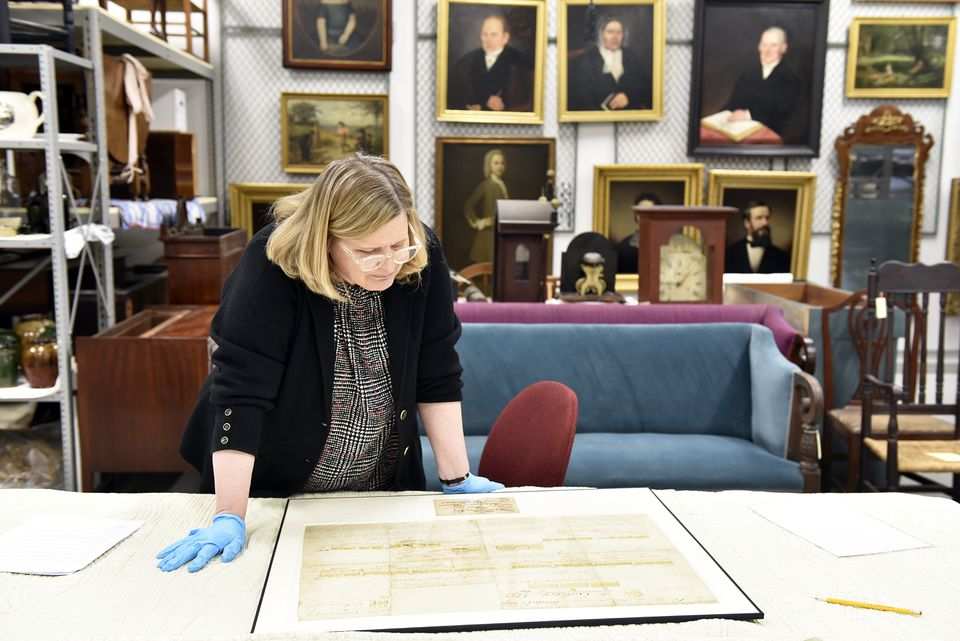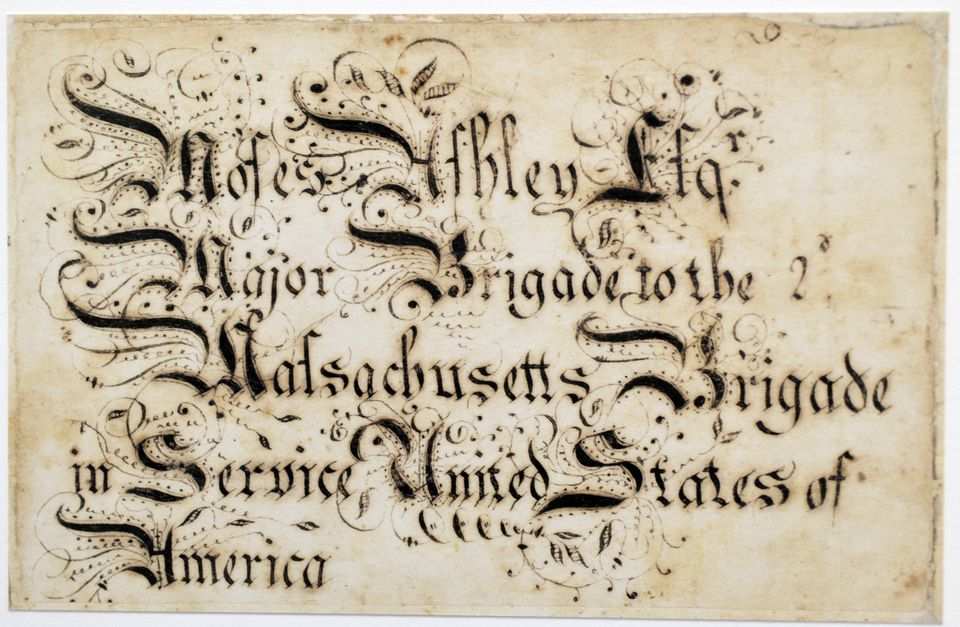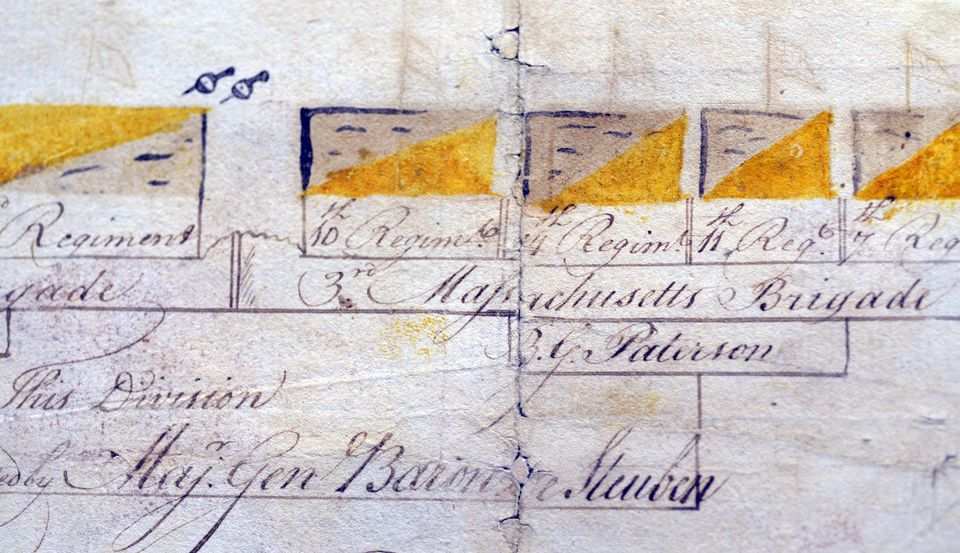The drawings are small, about the size of a tin toy soldier.
But they are still visible. Pen-and-ink sketches of soldiers mounted on horseback, their steeds depicted in yellow watercolor, are still vibrant after 241 years.
It’s not the type of thing you’d see on military plans prepared in 2021.

But on a plan from 1780 they show the care and attention their creator, Westfield native and Army engineer Moses Ashley, put into the 16¾-by-26-inch document. With penmanship flowing across the top of the page he titled it “The Line, or Order of Battle of the Army of the United States.” A square piece is missing, but the title continues, “ign 1780. Commanded by His Excellency Geo,” clearly a reference to George Washington.
The document, a plan for defending West Point in New York following the treason of Benedict Arnold, was lost to history for generations.
“No one was looking for it,” said Amanda Lange, curatorial department director and curator of historic interiors at Historic Deerfield.
Historic Deerfield president emeritus Philip Zea spied the document at an estate action in 2018. The museum and cultural center, which collects early American art and antiquities, bought it for about $15,000.
Then, over about 18 months, antique documents experts at Williamstown Art Conservation Center in the Berkshires cleaned and restored the plan. Conservators removed a label, removed mold and strengthened tears that had developed where the plan had been folded up.

The work cost $3,300, a bill paid with a grant from The Society of the Cincinnati, Lange said.
The society was founded by American and French military officers of the Revolutionary War. Today, it’s a hereditary organization with the eldest son eligible to take his ancestor’s place. The society took its name from an ancient Roman leader, Lucius Quinctius Cincinnatus, and lent the name to the city in Ohio. George Washington is sometimes referred to as the American Cincinnatus.
As part of the grant, Historic Deerfield has placed a high-quality facsimile of the battle plans in the society’s Washington headquarters.
The real document is now at Historic Deerfield, available to scholars or anyone who makes an appointment to see it, Lange said.
Historic Deerfield plans to display the battle plan soon as part of a larger exhibition. It will be surrounded by other everyday objects — like the extensive collection of gunpowder horns Zea has curated — highlighting the day-to-day lives of Revolutionary War soldiers, Lange said.

“Looking at things from the citizen-soldiers point of view, the militia, the volunteers,” Lange said. “Not from Washington’s point of view.”
Expect that exhibit to open in about the year 2026, in time for the 250th anniversary of the Declaration of Independence and as part of the statewide Revolution 250 effort.
The document might be one of the earliest uses of the term “United States of America,” Lange said. The term was officially adopted by the Continental Congress in 1776.
Ashley, designer of the battle plan, was born in 1749 in Westfield to a prominent family. He graduated from Yale College in 1767 and later lived on his family’s farm in Berkshire County. Ashley served as a lieutenant during the Lexington Alarm of 1775 and was a captain when he drew up the battle plan.

He evidently thought of himself as an up-and-comer. There’s a surviving letter where he pestered Washington about a promotion.
Ashley was an educated man, Lange said, and might have studied penmanship as a youngster under a “writing master.”
On Ashley’s battle plan, each regiment is represented by a yellow rectangle. The artillery units are represented by pictures of cannons.
The battle plan is written in iron gall ink, common at the time but destructive over time, on paper made from cotton rags.
“Imagine all these people at a meeting,” Lange said. “Ashely would have written out a rough, rough, sketch of the plan then he would have come back and done all this work on the final copy.”
So proud was he that later — historians don’t know when — Ashley affixed a label on the plans, declaring proudly that he created the document while “In Service, United States of America.”

While Ashley isn’t one of the famous Founding Fathers, he name-checks most of them in the battle plan, labeling formations from regiment, battalion and brigade to division and corps neatly with the name of its commander.
One was Col. Henry Knox, notable for transporting 59 cannons from Fort Ticonderoga in New York to Boston, by way of Springfield and other area towns, in 1775. The route is known as the Knox Trail to this day.
Also mentioned are Maj. General Nathanael Greene; Brig. Gen. John Stark, hero of the Battle of Bennington; and Brig. Gen. “Mad Anthony” Wayne, known for his fiery temper. The dragoons — soldiers who rode horses to the battle site and then fought on foot — were under the command of Henry “Light Horse Harry” Lee.
Lafayette, he is here too. Maj. Gen. Gilbert du Motier, the French marquis de La Fayette, is listed as commanding a major formation.
There is another foreign general, Baron Friedrich Von Steuben, who’d come from Prussia and helped train the American militiamen into a disciplined fighting force.
Ashely’s battle plan also includes a name from close to his own home. Westfield’s Gen. William Shepard commands a regiment.

Lange said the way troops are organized also shows that Ashley and those around him were already thinking in terms of a United States. Commanders are no longer assigned based on their home states. Brig. Gen. John Paterson was from New York and New Jersey. But he’s shown commanding men from Massachusetts. You wouldn’t have seen that much earlier in the war.
Ashley drew up the plan after Arnold’s foiled attempt to put West Point into British hands. Defending the strategic chokepoint in the Hudson River was crucial to keeping the British at bay.
“What happens if they come?” Lange said. “This is their plan to be ready, which units goes out first, which units hold back, who holds the other side of the river.”
It’s a battle that was never fought. The British never attacked in 1780 or in the subsequent years of the war.
There is correspondence indicating that Ashely continued to serve in the lower Hudson Valley until June of 1783, or about the end of the war, and did get promoted to major. He later settled in Stockbridge and drowned in 1791 while building a dam.
___
© 2021 Advance Local Media LLC
Distributed by Tribune Content Agency, LLC.



